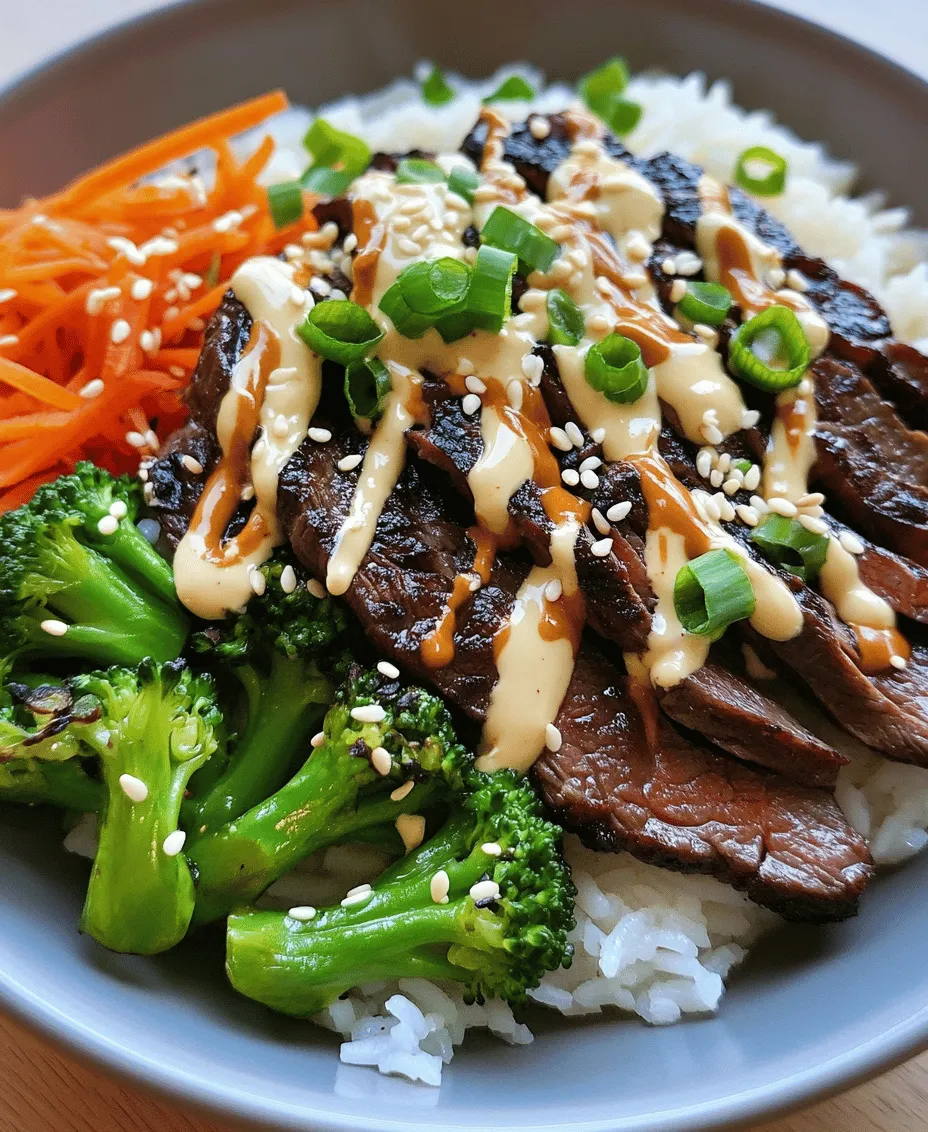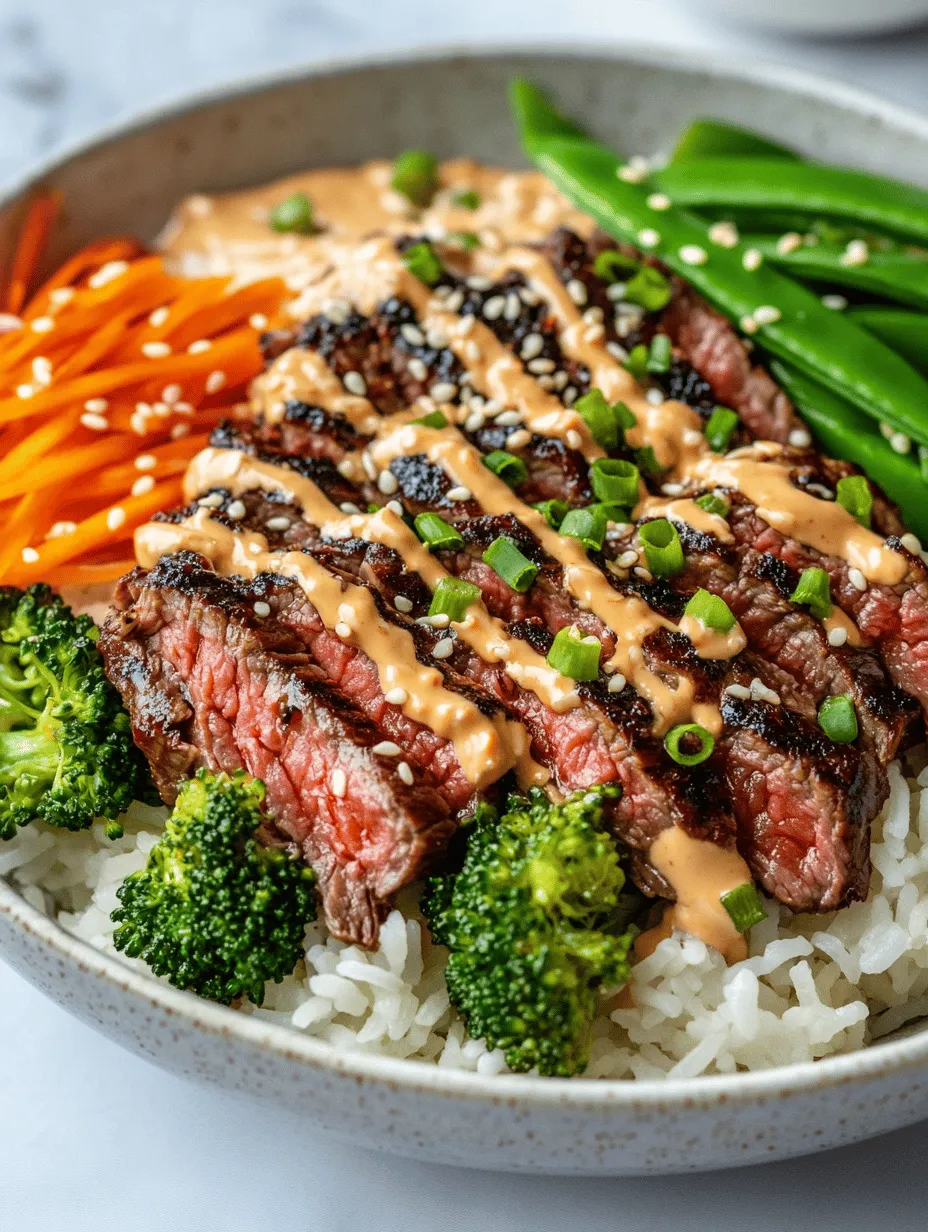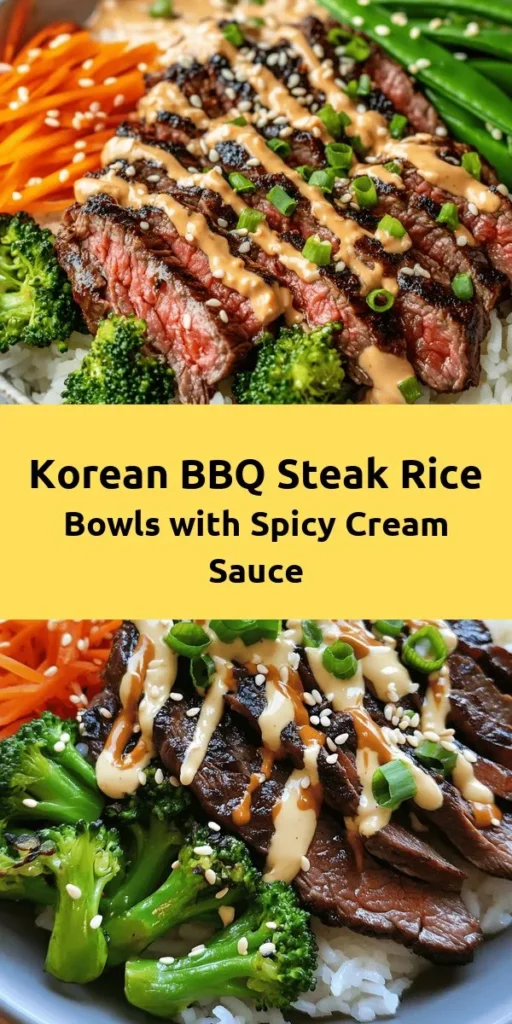Korean cuisine is a culinary treasure trove that captivates food lovers with its bold flavors and vibrant dishes, marked by a harmonious blend of savory, spicy, and sweet elements. Among the many gems in this rich culinary landscape, the Korean BBQ Steak Rice Bowl with Spicy Cream Sauce stands out as a delightful meal that can easily become a weeknight favorite. This dish harmonizes tender, marinated steak with fluffy jasmine rice and a colorful array of vegetables, all crowned with a luxurious and spicy cream sauce that elevates the dining experience to new heights.
The Korean BBQ Steak Rice Bowl is not only a feast for the senses but also a reflection of Korea’s deep-rooted culinary traditions, where grilling and marinating are regarded as essential cooking techniques. The dish is a perfect representation of the balance and contrast that defines Korean cuisine, showcasing the umami flavors of the meat, the freshness of the vegetables, and the creamy heat of the sauce. Whether you’re a seasoned home cook or a novice in the kitchen, this recipe promises to deliver a satisfying meal that celebrates the essence of Korean BBQ.
In this article, we will delve into the intricacies of this delicious recipe, explore its cultural significance, and provide a step-by-step guide to help you recreate this amazing dish in your own kitchen. So, let’s get started on a culinary journey that will transport your taste buds straight to Korea!
Understanding the Key Ingredients
The foundation of any great dish lies within its ingredients. For the Korean BBQ Steak Rice Bowl, each component plays a crucial role in creating a symphony of flavors and textures. Let’s explore the main ingredients that contribute to this delightful meal.
The Steak: Choosing the Right Cut
When it comes to the star of the show— the steak— selecting the right cut is paramount. Flank steak and sirloin steak are two popular choices that not only offer great flavor but also a satisfying texture when cooked correctly.
Flank Steak: Known for its rich flavor and fibrous texture, flank steak is ideal for marinating. It absorbs flavors beautifully and becomes incredibly tender when cooked to medium-rare. This cut is best when sliced against the grain, which helps to break down the fibers and yield a more tender bite.
Sirloin Steak: Another excellent choice, sirloin steak is slightly more tender than flank steak, making it a great option for those who prefer a milder flavor. It also holds up well during grilling, providing a juicy and satisfying base for the rice bowl.
The marinating process is vital for enhancing the flavor of the steak. A well-crafted marinade can infuse the meat with complex flavors and tenderize it, making each bite a burst of deliciousness. A typical marinade for Korean BBQ includes ingredients such as soy sauce, sesame oil, garlic, and ginger, which come together to create a savory base that complements the natural richness of the beef. Aim to marinate the steak for at least 30 minutes, although longer marinating times—up to 24 hours—can yield even more flavor.
The Rice: The Perfect Base
The next essential component of our Korean BBQ Steak Rice Bowl is the rice. Jasmine rice is the preferred choice for this dish due to its fragrant aroma and slightly sticky texture, which allows it to clump together beautifully without becoming gummy. This quality makes jasmine rice perfect for holding up against the savory flavors of the steak and the creamy sauce.
If you’re looking for alternatives due to dietary preferences, there are several options available. Brown rice is a nutritious substitute that offers a nuttier flavor and more fiber. Quinoa is another great choice for those seeking a gluten-free or protein-rich option. Each of these alternatives brings its unique characteristics to the dish, allowing you to tailor the recipe to your tastes and dietary needs.
The Vegetables: Adding Color and Nutrients
Vegetables are not only a source of nutrition but also add vibrant colors and textures to the Korean BBQ Steak Rice Bowl. A medley of broccoli, carrots, and snap peas provides a delightful crunch and a pop of color that enhances the overall presentation of the dish.
Broccoli: This nutrient-rich vegetable is packed with vitamins C and K, making it a powerhouse of health benefits. Its slightly bitter taste complements the savory flavors of the steak beautifully.
Carrots: Sweet and crunchy, carrots provide a refreshing contrast to the rich flavors in the dish. They are also a great source of beta-carotene, which is beneficial for eye health.
Snap Peas: These tender, sweet peas add a delightful crunch and a burst of freshness to the bowl. They are low in calories and high in fiber, making them a healthy addition to the meal.
Incorporating these vegetables not only boosts the nutritional profile of the dish but also enhances its textural contrast, ensuring each bite is a delightful experience.
The Spicy Cream Sauce: A Flavorful Finishing Touch
No Korean BBQ Steak Rice Bowl would be complete without the signature spicy cream sauce that ties everything together. This sauce is a divine blend of flavors, featuring key ingredients such as gochujang (Korean red chili paste) and mayonnaise.
Gochujang: This fermented chili paste is a staple in Korean cooking, prized for its unique combination of heat, sweetness, and umami. Its deep red color and complex flavor profile elevate the dish and give it a characteristic Korean flair.
Mayonnaise: Adding mayonnaise to the sauce creates a creamy texture that balances the heat from the gochujang. The richness of the mayonnaise helps to mellow the spice, making it approachable for all palates.
Together, these ingredients create a sauce that is not only flavorful but also adds a luxurious creaminess that elevates the entire dish. Drizzle it generously over the rice bowl for a satisfying finish that complements the marinated steak and fresh vegetables.
Step-by-Step Guide to Making Korean BBQ Steak Rice Bowls
Now that we have a solid understanding of the key ingredients that make up the Korean BBQ Steak Rice Bowl, let’s walk through the detailed process of creating this delicious dish.
Marinating the Steak for Maximum Flavor
The first step in making your Korean BBQ Steak Rice Bowl is to marinate the steak. This process is essential for infusing the meat with flavor and ensuring it remains tender during cooking. Here’s how to do it effectively:
1. Prepare the Marinade: In a mixing bowl, combine soy sauce, sesame oil, minced garlic, grated ginger, and a touch of sugar. Whisk these ingredients together until the sugar is dissolved.
2. Marinate the Steak: Place your chosen cut of steak in a resealable plastic bag or a shallow dish. Pour the marinade over the steak, ensuring it is evenly coated. Seal the bag (or cover the dish) and refrigerate.
3. Marinating Time: Allow the steak to marinate for at least 30 minutes, but for the best results, aim for 2-24 hours. The longer the steak marinates, the more flavorful it will become.
4. Remove and Drain: After marinating, take the steak out of the refrigerator and let it rest at room temperature for about 15-20 minutes before cooking. This helps to ensure even cooking. Drain the excess marinade, but don’t discard it—save it for brushing on the steak while grilling.
Cooking the Perfect Jasmine Rice
While the steak is marinating, you can prepare the jasmine rice. Follow these steps to cook perfect jasmine rice:
1. Rinse the Rice: Start by rinsing 1 cup of jasmine rice under cold water until the water runs clear. This step removes excess starch and prevents the rice from becoming overly sticky.
2. Cook the Rice: In a medium saucepan, combine the rinsed rice with 1 1/2 cups of water. Bring to a boil over medium-high heat. Once boiling, reduce the heat to low, cover the pot, and simmer for about 15 minutes, or until the water is absorbed.
3. Let it Rest: After the rice is cooked, remove it from the heat and let it sit, covered, for an additional 5-10 minutes. This allows the rice to steam and become fluffy.
4. Fluff the Rice: Use a fork to fluff the rice gently before serving. This will help separate the grains and enhance the texture.
By following these initial steps, you’re well on your way to creating a delicious Korean BBQ Steak Rice Bowl with Spicy Cream Sauce. In the next part of this article, we will continue with the cooking process, including grilling the steak, sautéing the vegetables, and assembling the final dish for a mouthwatering meal that is sure to impress!

Cooking Jasmine Rice: Achieving Fluffy and Tender Grains
Cooking jasmine rice to perfection is key to creating a delicious Korean BBQ steak rice bowl. Here’s how to achieve those fluffy, tender grains that complement your ingredients beautifully.
1. Rinse the Rice: Start by measuring out 1 cup of jasmine rice. Place the rice in a fine-mesh strainer and rinse it under cold water for about 2-3 minutes. This process removes excess starch, which helps to prevent the rice from becoming gummy.
2. Soak the Rice (Optional): For even fluffier rice, consider soaking the rinsed rice in water for 30 minutes. Drain the rice again before cooking.
3. Cooking the Rice: In a medium saucepan, combine the rinsed (and soaked) rice with 1 ½ cups of water. Add a pinch of salt for flavor. Bring the water to a boil over medium-high heat. Once boiling, reduce the heat to low, cover the saucepan with a lid, and let it simmer for about 15 minutes. Avoid lifting the lid during this time, as it allows steam to escape.
4. Let It Rest: Once the cooking time is complete, remove the saucepan from heat but keep the lid on. Let the rice sit for an additional 10 minutes. This resting period allows the rice to absorb any remaining moisture, resulting in perfectly cooked grains.
5. Fluff the Rice: After resting, remove the lid and use a fork to fluff the rice gently. This will help separate the grains and enhance the overall texture.
6. Keep Warm: To ensure the rice stays warm until serving, transfer it to a heatproof bowl and cover it with a clean kitchen towel. This will keep the moisture in and prevent the rice from drying out.
Preparing the Vegetables: Techniques for Optimal Texture
Vegetables add freshness and crunch to your Korean BBQ steak rice bowls. Here’s how to prepare them for optimal texture and flavor.
Blanching Broccoli for Vibrant Color
1. Prepare the Broccoli: Cut the broccoli into florets, ensuring they are uniform in size for even cooking.
2. Blanching Process: Bring a pot of salted water to a rolling boil. Once boiling, add the broccoli florets and cook for 2 minutes. This quick cooking method retains the broccoli’s bright green color and crisp texture.
3. Ice Bath: Immediately transfer the blanched broccoli to a bowl of ice water. This stops the cooking process and helps preserve the vibrant color. After a few minutes, drain and set aside.
Sautéing Vegetables for Desired Tenderness
1. Choose Your Vegetables: In addition to broccoli, consider adding bell peppers, carrots, or snap peas for additional color and flavor.
2. Sautéing Technique: Heat a tablespoon of cooking oil in a large skillet over medium-high heat. Add the vegetables and stir-fry for 3-5 minutes, or until they reach your desired tenderness. Aim for a slight crunch to maintain texture.
3. Seasoning: Season the sautéed vegetables with a pinch of salt and pepper to enhance their natural flavors.
Cooking the Steak: Achieving the Ideal Doneness
Cooking the steak to perfection is crucial for your Korean BBQ steak rice bowls. Here’s how to achieve that ideal doneness.
1. Choosing the Steak: Use a high-quality cut of steak, such as ribeye, sirloin, or flank steak. These cuts are tender and flavorful, perfect for grilling.
2. Grilling Techniques: Preheat your grill or grill pan over medium-high heat. Season the steak generously with salt, pepper, and your favorite Korean marinade or spices before placing it on the grill. Cook for 4-5 minutes on one side, then flip and cook for another 3-4 minutes. For a medium-rare steak, aim for an internal temperature of 135°F (57°C).
3. Resting the Steak: After grilling, remove the steak from the heat and let it rest on a cutting board for at least 5-10 minutes. Resting allows the juices to redistribute throughout the meat, making it more tender and flavorful.
4. Slicing the Steak: When ready to serve, slice the steak against the grain into thin strips. This technique helps ensure maximum tenderness and makes it easier to enjoy in your rice bowl.
Creating the Spicy Cream Sauce: A Quick and Easy Recipe
The spicy cream sauce elevates the flavors of your Korean BBQ steak rice bowls. Here’s how to whip it up in no time.
1. Gather Your Ingredients: You will need ½ cup of sour cream, 2 tablespoons of mayonnaise, 1 tablespoon of gochujang (Korean chili paste), 1 teaspoon of soy sauce, and 1 teaspoon of lime juice. Adjust the quantities to suit your taste preferences.
2. Mix the Ingredients: In a small bowl, combine the sour cream, mayonnaise, gochujang, soy sauce, and lime juice. Whisk the mixture until smooth and well-blended.
3. Adjust the Heat Level: Taste the sauce and adjust the spiciness by adding more gochujang if desired. For a milder sauce, reduce the amount of gochujang or add a bit of honey to balance the heat.
Assembling the Rice Bowls: Presentation Matters
The presentation of your rice bowls enhances the dining experience. Here’s how to layer the ingredients for visual appeal and balanced flavor.
1. Base Layer: Start with a scoop of fluffy jasmine rice as the base layer in each bowl. This will absorb the flavors of the sauce and other ingredients.
2. Add Grilled Steak: Next, arrange the sliced grilled steak over the rice. This not only provides a hearty protein source but also adds a beautiful contrast in color.
3. Layer the Vegetables: Neatly place the blanched broccoli and sautéed vegetables around the steak. This arrangement not only looks appealing but also ensures that every bite contains a mix of flavors.
4. Drizzle the Spicy Cream Sauce: Generously drizzle the spicy cream sauce over the top of the bowl. This not only adds flavor but also creates a visually pleasing finish.
5. Garnishing: To elevate the dish further, consider garnishing with sesame seeds, sliced green onions, or a sprinkle of chopped cilantro. These garnishes add freshness and enhance the overall presentation.
Nutritional Information: A Balanced Meal
Understanding the nutritional content of your meal is essential for maintaining a balanced diet. Here’s a breakdown of the components in your Korean BBQ steak rice bowls.
– Calories: A typical serving of these rice bowls contains approximately 600-800 calories, depending on portion sizes and specific ingredients used.
– Protein: The steak provides a healthy dose of protein, roughly around 30-40 grams per serving, which is essential for muscle repair and overall health.
– Carbohydrates: Jasmine rice contributes about 45-60 grams of carbohydrates, providing energy and serving as the base of the meal.
– Fats: The spicy cream sauce adds some healthy fats from the mayonnaise and sour cream, contributing to satiety.
– Vitamins and Minerals: The vegetables add essential vitamins and minerals, such as Vitamin C and fiber, promoting overall health and aiding digestion.
This recipe fits well into a balanced diet by providing a mix of protein, carbohydrates, and healthy fats, along with plenty of vegetables for added nutrients.
Cultural Context: The Significance of BBQ in Korean Cuisine
Korean BBQ holds a special place in the hearts of many and is an integral aspect of Korean culinary culture. The communal spirit of sharing meals is deeply rooted in Korean tradition, where dining with family and friends is celebrated.
Traditionally, Korean BBQ involves grilling various meats at the table, allowing diners to customize their own dishes. This interactive dining experience fosters connection and enjoyment among friends and family. The flavors of marinated meats, combined with fresh vegetables and flavorful sauces, create a feast that is both satisfying and memorable.
By enjoying Korean BBQ steak rice bowls, you are not only indulging in a delicious meal but also embracing the spirit of sharing and togetherness that defines Korean cuisine.
Conclusion: Enjoying Your Korean BBQ Steak Rice Bowls
In conclusion, the Korean BBQ Steak Rice Bowl with Spicy Cream Sauce is a vibrant and flavorful dish that encapsulates the essence of Korean cuisine. By following the detailed steps outlined in this recipe, you can create a delicious and balanced meal that is perfect for any occasion. Whether you choose to share this meal with family or savor it on your own, each bite will transport you to the heart of Korean BBQ culture.
Explore the rich flavors and ingredients that make this dish unique, and don’t hesitate to customize it to suit your personal taste. Enjoy your culinary journey as you embrace the vibrant world of Korean BBQ in the comfort of your home!



